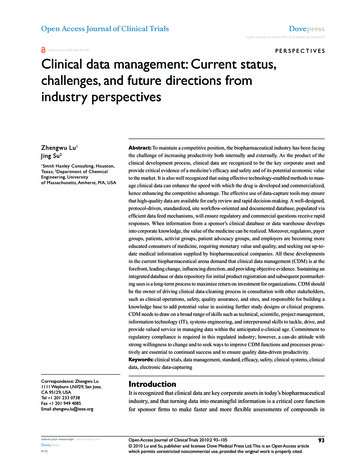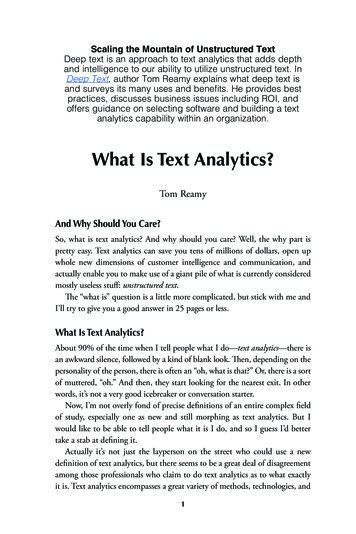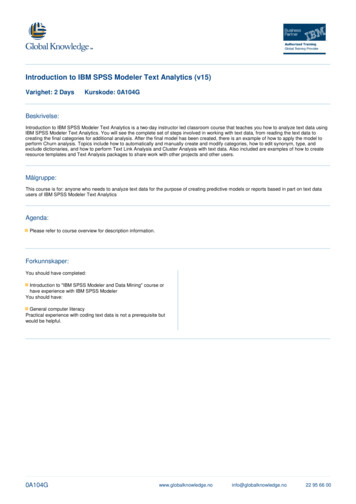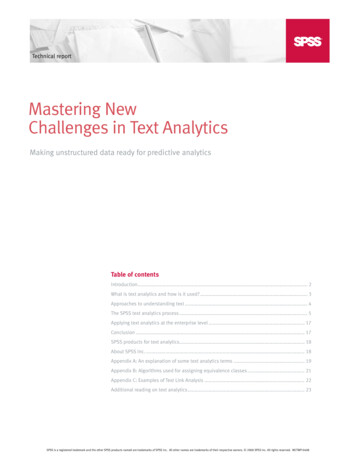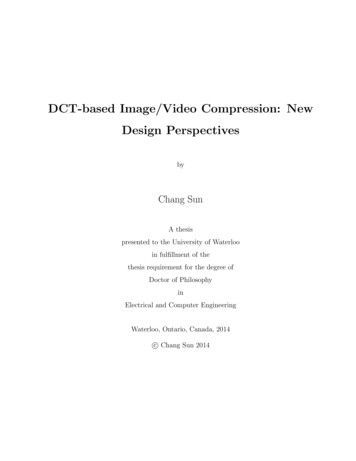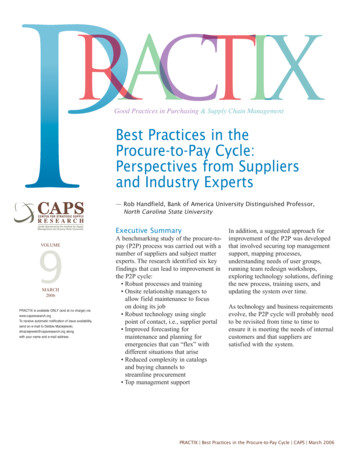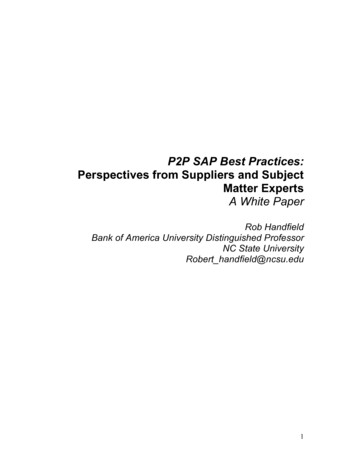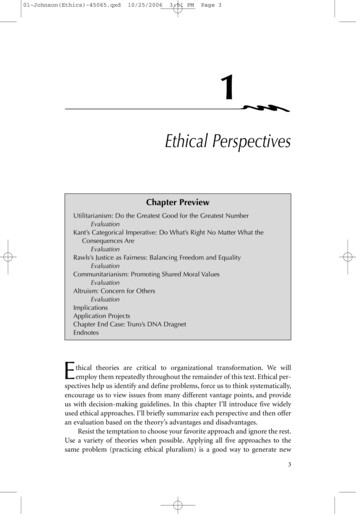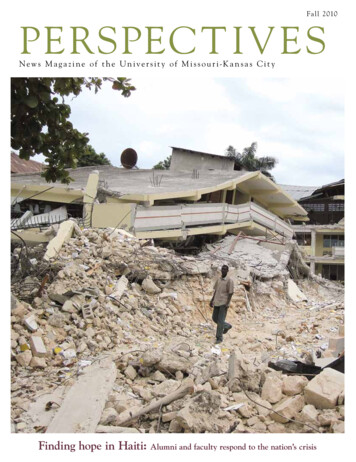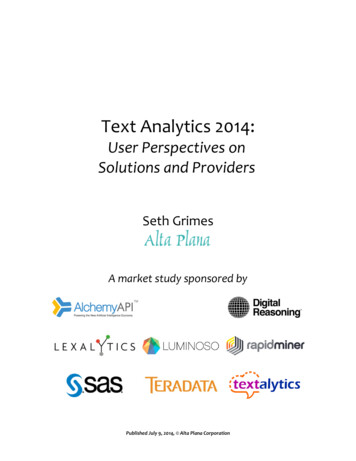
Transcription
Text Analytics 2014:User Perspectives onSolutions and ProvidersSeth GrimesA market study sponsored byPublished July 9, 2014, Alta Plana Corporation
Text Analytics 2014: User Perspectives on Solutions and ProvidersTable of ContentsExecutive Summary . 3Growth Drivers . 4Key Study Findings . 5About the Study and this Report .6Text Analytics Basics . 7Patterns . 7Structure . 7Metadata .8Beyond Text .8Applications and Markets .8Solution Providers .9Market Progress .9Demand-Side Perspectives . 10Study Context . 10About the Survey . 10The Data Mining Community . 11Demand-Side Study 2014: Survey Findings .13Understanding Survey Respondents . 13Q2: Application Areas . 15Q3: Information Sources . 16Q4: Return on Investment . 16Q5: Mindshare; Awareness . 17Q6: Spending. 19Q8: Satisfaction . 20Q9: Overall Experience . 22Q11: Provider Selection . 25Q12: Provider Likes and Dislikes . 27Q13: Promoter? . 31Q14: Information Types . 32Q15: Important Properties and Capabilities . 33Q16: Languages . 36Q17: BI Software Use . 37Q18: Guidance . 37Q19: Comments . 41Additional Analysis. 42Interpretive Limitations and Judgments . 43Sponsor Solution Profiles .44Solution Profile: AlchemyAPI . 46Solution Profile: Digital Reasoning . 48Solution Profile: Lexalytics .50Solution Profile: Luminoso . 52Solution Profile: RapidMiner . 54Solution Profile: SAS .56Solution Profile: Teradata Aster.58Solution Profile: Textalytics . 60 2014 Alta Plana Corporation2
Text Analytics 2014: User Perspectives on Solutions and ProvidersExecutive SummaryText analytics, applied to social, online, and enterprise data, aims to extract useful informationand create usable insights for business, personal, government, and research ends. Thetechnology is pervasive, even if not ubiquitous, which is to say that it is deployed in applicationsranging in scale from device-installed to distributed, “total information awareness” data mining.Text analytics is utilized wherever big/fast text is found. And while not every analyticalapplication directly involves text, in our emerging big-data world, every task – including analysesof “machine data” and transactional records – may be enriched by the inclusion of text-sourcedinformation.Text analytics has found its greatest success in four industry groupings: consumer-facingbusinesses, public administration and government, life sciences and clinical medicine, andscientific and technical research. Analysis of online news, social postings, and enterprisefeedback is of special interest across groupings. Search-driven applications – search,advertising, e-discovery, customer service – is a crosscutting functional category, aimed atmeeting front-line, operational needs.Users seek to extract many sorts of information, with continued growing interest in automatedidentification of topics, entities and concepts, events, and personal attributes, coupled withfeature-linked intent and sentiment – attitudes, emotions, and opinions – as well as othersubjective information. User experiences with the technology and solutions remain mixed,however.These points and more are brought out in Alta Plana’s report “Text Analytics 2014: UserPerspectives on Solutions and Providers.” The report opens with an executive summary andincludes three components: a narrative analysis of the text analytics market, findings of amarket study, and sponsor solution profiles.The User PerspectiveThere is no single or typical text analytics user, application, technology, or solution. Users anduses vary by industry, business function, information source, and goal.In 2011, we observed, “tools and solutions now cover the gamut of business, research, andgovernmental needs.” The technology covers – or is capable of covering – the variety of humanlanguages, text sources, information types, and industries, handling large-volume andstreaming big data.Data scientist users perform text analyses using one or more of the several available textcapable software-development or data-analysis environments. Business users naturallygravitate toward functional solutions with embedded text analytics.One new point: Many text analytics users don’t understand that they’re doing text analytics, nordo they need to.The Provider MarketGrowth in text analytics, as a vendor market category, has slackened, even while adoption oftext analytics, as a technique, has continued to expand rapidly.The 2014 market is fragmented, featuring software tools, natural language processing (NLP)services, text analysis workbenches, social analytics dashboards, integrated data analysisenvironments, and solution-embedded technologies. These options support the practice of textanalytics, but a large, increasing segment do not place text analytics front and center. Rather,text analytics operates behind the scenes, often as just one of several analytics elements –leading to my observation about the text analytics market category.Technology and solution providers run the gamut in size from small start-ups, to establishedtechnology and solution companies, to the largest, global information technology brands. Someofferings are tightly focused on a particular function – for instance, single-language event or 2014 Alta Plana Corporation3
Text Analytics 2014: User Perspectives on Solutions and Providerssentiment extraction – while others embed text analysis capabilities in a line-of-businesssolution and others offer robust business intelligence (BI) and analytics suites.Innovation is constant, related to scale, scope, and velocity of analyses; deployment oftechniques such as deep learning and unsupervised learning; availability of linguistic andsemantic resources; refinement of proven, rule-based approaches; closer adaptation to industryneeds; and internationalization. Business value resides in all parts of the market, even if nottypically under the text analytics banner.Growth DriversMany of us operate on the notion that every aspect of life and business can and should berecorded, measured, and analyzed for predictive purposes and optimization – including ourlanguage-based communications. Text technologies and applications have advanced inresponse. Sensors, devices, and social computing have created an always-on, real-timeimperative, and the availability of cloud and mobile options now facilitate adoption anddeployment of new technologies. The rapid increase in computing power and data availabilityhas enabled deployment of new algorithms that tackle challenges formerly beyond commoditycomputing’s capacity.Consider four technology-related growth drivers: Open source text analytics – via data-acquisition, information-extraction, classification,and analytical components – is stronger than ever. Open source lowers barriers both totechnology adoption for researchers and more-sophisticated users, and to solutionproviders, who can focus on building higher-level and domain-adapted capabilities.Frameworks such as UIMA, Gate, Python, and R; Hadoop and other parallel processingtechnologies; and stream and graph processing, for instance, via Apache Spark andApache Storm, are of particular interest. The API economy – e.g., hosted, on-demand, via-API Web services – similarly lowersentry barriers and provides enormous flexibility for adopters. Data availability creates analytics demand, and data has never been more available,whether directly collected or acquired via services such as DataSift, Gnip, Moreover,and Xignite. Synthesis will increasingly automate online commerce, customer support, healthservice delivery, and other applications as systems continue to mature and are joinedby other question answering technologies. IBM Watson and Wolfram Alpha exemplifythe synthesis trend.There are notable market drivers as well: Customer interactions: Customer service and customer experience are strong textanalytics growth drivers, deploying text analytics to data from traditional channels suchas contact centers and extending coverage to move social initiatives from listening, toengagement, to service optimization. Omnichannel solutions: Natural language processing (NLP) capabilities are essential incompetitive voice-of-the-customer (VOC) programs and for customer interactionanalytics efforts that join text- and speech-derived data to operational data. Text,speech, and operational analyses, applied to survey, social media, news, warranty, chat,and voice sources, form part of omnichannel solutions that crunches data collectedacross the full set of customer touchpoints, from contact center, online, chat, social,email, and in-store interactions. Consumer and market insights: Text analytics application in the insights industry –notably new or next-generation market research – has much in common with theinteraction/experience analytics use case. Insights researchers also study VOC, mostoften via enterprise feedback management (EFM) programs that rely on surveys and 2014 Alta Plana Corporation4
Text Analytics 2014: User Perspectives on Solutions and Providersvia social analyses. Social is increasingly viewed as a credible research source that cansupplement surveys by delivering complementary insights. Search and search-based applications: Search has expanded far beyond enterprise andonline information retrieval to provide a platform for high-value applications thatinclude advertising, e-discovery and compliance, business intelligence (BI) in the formof unified information access (UIA), and customer self-service. Health care and clinical medicine: While life-sciences researchers were among theearliest text mining adopters, uptake for related areas involving mining beyondscientific literature has taken longer to advance. Analytics ranging from diagnosticsystems to claims analysis have begun pacing a segment of the text analytics market.The SurveyAlta Plana’s 2014 text analytics market study combines a survey-based, quantitative andqualitative examination of usage, perceptions, and plans, with observations derived fromnumerous conversations with solution providers and users. It seeks to answer the question,“What do current and prospective text analytics users think of the technology, solutions, andsolution providers?” Responses will help providers craft products and services that better serveusers. Findings – both numerical tabulations and free-text verbatims – will guide users seekingto maximize benefit for their own organizations.Alta Plana received 220 valid survey responses between January 18 and April 15, 2014, 193 ofthem during the first four weeks, when we actively publicized the survey. The 220 figure is fourfewer than the 224 responses connected to the 2011 study. This document reports findings and,when appropriate, contrasts them with comparable numbers from Alta Plana’s 2009 and 2011text analytics market studies (available for free download Key Study FindingsThe following are key 2014 study findings: The big news is not news at all: Social remains by far the most popular source fuelingtext analytics initiatives. Four of the top five information categories are social/online (asopposed to in-enterprise) sources: blogs and other social media (61%)news articles (42%)comments on blogs and articles (38%)online forums (36%)Respondents chose an average of 5.6 sources, compared to 4.5 in 2011.Direct customer feedback, in the form of customer/market surveys, rated 37%, squeezing inat fourth place. Interestingly, the percentage listing e-mail and correspondence as aninformation source dropped from 36% in 2009, to 29% in 2011, to 26% in 2014. All four top capabilities that users look for in a solution – each garnering over 50%selection – relate to getting the most information out of sources: the ability to generate categories or taxonomies [which would include topicextraction] (64%)the ability to use specialized dictionaries, taxonomies, ontologies, orextraction rules (54%)broad information extraction capabilities (53%)document classification (53%)Deep sentiment/emotion/opinion extraction was chosen by 45% of respondents, down from57% in 2011. 2014 Alta Plana Corporation5
Text Analytics 2014: User Perspectives on Solutions and ProvidersLow cost was important to 44% of respondents, up from 38% in 2011, but down from 51% of2009 responses. Top business applications of text/content analytics for respondents are the following: brand/product/reputation management (38%)voice of the customer/customer experience management (39%)research (38%)competitive intelligence (33%)search, information access, or question-answering (29%) Seventy-four percent of users are Satisfied or Completely Satisfied with text analyticsand 22% are Neutral with only 4% Disappointed or Very Disappointed. Dissatisfaction isgreatest, at 29%, with ease of use and with availability of professional services/support,with only 50% satisfied in each category. Only 48% of users are likely to recommend their most important provider, nearlyunchanged from the 2011 figure. However, 36% would recommend against their mostimportant provider, up from 28% in 2011.About the Study and this ReportSeth Grimes, an industry analyst and consultant who is a recognized authority on the textanalytics marketplace – technologies, solutions, and providers – designed and conducted thestudy “Text Analytics 2014: User Perspectives on Solutions and Providers” and wrote thisreport.The author is grateful for the support of the eight study sponsors, AlchemyAPI, DigitalReasoning, Lexalytics, Luminoso, RapidMiner, SAS, Teradata, and Textalytics. Theirsponsorships allowed him to conduct an editorially independent study that should promoteunderstanding of the text analytics market and of user-indicated implementation andoperations best practices. The solution profiles that follow the report’s editorial matter wereprovided by the sponsors and included with only minor editing to regularize their layout.Otherwise, the author is solely responsible for the editorial content of this report, which wasnot reviewed by the sponsors prior to publication.This report opens with a text analytics and applications backgrounder that refreshes materialfrom the previous study report. 2014 Alta Plana Corporation6
Text Analytics 2014: User Perspectives on Solutions and ProvidersText Analytics BasicsThe term text analytics describes software and transformational processes that uncoverbusiness value in “unstructured” text. Text analytics applies statistical, linguistic, machinelearning, and data analysis and visualization techniques to identify and extract salientinformation and insights. The goal is to inform decision-making and support businessoptimization.PatternsText, images, speech, and video are all directly understan
Jul 09, 2014 · earliest text mining adopters, uptake for related areas involving mining beyond scientific literature has taken longer to advance. Analytics ranging from diagnostic systems to claims analysis have begun pacing a segment of the text analytics market. The Survey Alta Plana’s 2014 text analyti
